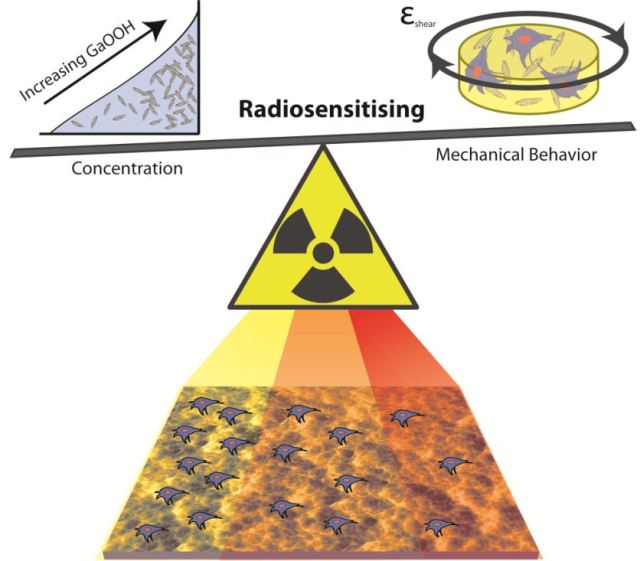Feb 24 2016

Researchers from a number of disciplines at North Carolina State University collaborated to create a composite material capable of emitting heat and light when exposed to radiation of specific wavelengths. The material can also be customized to possess specific mechanical features. This composite could possibly be adapted for use in drug delivery, biomedical imaging, and therapeutic treatments.
The radiosensitivity is what makes the material useful for biomedical applications, and the ability to tune the mechanical properties makes it less likely to be rejected by the surrounding tissue in the body.
Nora Berg, Ph.D., NC State
The material is a composite of a biological gel created using gallium oxyhydroxide (GaOOH) and proteins. The GaOOH in the form of crystals, which measure 200 - 300 nm in diameter and about 1 μ in length, are dispersed in the biological gel.
“When the composite is exposed to wavelengths of radiation that would be used in clinical settings, the GaOOH responds by heating up and emitting light,” Berg says.
This response to radiation makes it attractive for use in some therapeutic applications. The radiosensitive response can help generate reactive oxygen species – like peroxide – that can be used to kill cells. So, this material may have value for targeting localized cancer sites.
Albena Ivanisevic, Professor of Materials Science and Engineering, NC State
By modifying the concentration of GaOOH, the mechanical properties of the composite can be adjusted. When the quantity of GaOOH is adjusted the structure of the gel gets changed, which influences the stiffness of the gel.
The team worked with Saad Khan’s research group in NC State’s Department of Chemical and Biomolecular Engineering to test the mechanical properties. They then conducted a proof-of-concept study to check whether the composite might interact with cells. Mouse-derived connective tissue cells known as fibroblasts were grown on the surface of composite samples. Next the team paired with researchers from NC State’s College of Veterinary Medicine to expose the cell-covered samples to varying quantities of clinically-relevant radiation.
They discovered that higher quantities of radiation increased cell death, and the same was the case with higher quantities of GaOOH.
This means that you can increase the concentration of GaOOH in the composite to cause cell death at targeted sites, while using less radiation.
Albena Ivanisevic, Professor of Materials Science and Engineering, NC State
Going forward, the team hope to assess the functioning of the composite with other cell types, such as neuronal cells, that are resistant to radiation.
The composite is relatively inexpensive and easy to make, and could be scaled up. It’s important to note that, while this has practical applications, it is fundamental work – we are still in the in vitro testing stage. A lot of work lies ahead before this will be viable for clinical use.
Albena Ivanisevic, Professor of Materials Science and Engineering, NC State
The research paper is published in the Applied Materials & Interfaces journal under the heading “Interfaces with Tunable Mechanical and Radiosensitizing Properties.” The paper was co-authored by NC State Ph.D. students Brady Pearce, Patrick Snyder, Nathaniel Rohrbaugh and Prajesh Adhikari; Michael Nolan, an assistant professor of radiation, oncology and biology at NC State; and Saad Khan, Alcoa Professor of Chemical and Biomolecular Engineering at NC State.